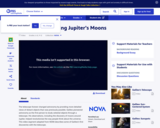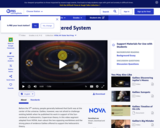
An introduction to Gravity, Weak, Electromagnetic and Strong Forces. Created by Sal Khan.
- Subject:
- Astronomy
- Physical Science
- Material Type:
- Lesson
- Provider:
- Khan Academy
- Provider Set:
- Khan Academy
- Author:
- Sal Khan
- Date Added:
- 11/22/2010

An introduction to Gravity, Weak, Electromagnetic and Strong Forces. Created by Sal Khan.

This annotated index includes a wide range of free, online labs appropriate for Astro 101 courses, organized by chapter of the OpenStax Astronomy textbook. So, you can look up free labs on Kepler's Laws, H-R diagram, the Drake Equation, and many other topics in introductory astronomy. These lab activities have been put on line by universities, NASA and NSF sponsored projects, and instructors who want to share their labs with colleagues.
If we have missed any labs that are available free online, please suggest additions by emailing fraknoi@fhda.edu

This course focuses on three particularly interesting areas of astronomy that are advancing very rapidly: Extra-Solar Planets, Black Holes, and Dark Energy. Particular attention is paid to current projects that promise to improve our understanding significantly over the next few years. The course explores not just what is known, but what is currently not known, and how astronomers are going about trying to find out.

In this Digital Universe activity, students learn firsthand about estimation strategies and observational bias. They estimate how common several celestial objects are based on their location and make inferences about larger population patterns throughout the galaxy. The printable PDF activity includes illustrated step-by-step instructions for the following hands-on and computer-assisted activities: Introduction to Celestial Objects, Broad Distribution of Objects in the Galaxy and Making Galactic Estimates

Collision of the Milky Way Galaxy with Andromeda (forming "Milkomeda"). Created by Sal Khan.

This video lesson has the goal of introducing students to galaxies as large collections of gravitationally bound stars. It explores the amount of matter needed for a star to remain bound and then brings in the idea of Dark Matter, a new kind of matter that does not interact with light. It is best if students have had some high school level mechanics, ideally Newton's laws, orbital motion and centripetal force. The teacher guide segment has a derivation of centripetal acceleration. This lesson should be mostly accessible to students with no physics background. The video portion of this lesson runs about 30 minutes, and the questions and demonstrations will give a total activity time of about an hour if the materials are all at hand and the students work quickly. However, 1 1/2 hours is a more comfortable amount of time. There are several demonstrations that can be carried out using string, ten or so balls of a few inches in diameter, a stopwatch or clock with a sweep second hand and some tape. The demonstrations are best done outside, but can also be carried out in a gymnasium or other large room. If the materials or space are not available, there are videos of the demonstrations in the module and these may be used.

The Milky Way is our neighborhood in the universe. It’s a galaxy and there are many others out there. Galaxies contain gas, dust, and billions of stars or more. They come in four main shapes: elliptical, spiral, peculiar, and irregular. Galaxies can collide, and grow in size by eating each other.
Chapters:
Introduction: Galaxies
Spiral Galaxies
Elliptical Galaxies
Galactic Collisions
Peculiar Galaxies
Irregular Galaxies
Review

Active galaxies pour out lots of energy, due to their central supermassive black holes gobbling down matter. Galaxies tend not to be loners but instead exist in smaller groups and larger clusters. Our Milky Way is part of the Local Group, and will one day collide with the Andromeda galaxy. Clusters of galaxies also clump together to form superclusters, the largest structures in the Universe. In total, there are hundreds of billions of galaxies in the Universe.
Chapters:
Introduction: Active Galaxies
Active Galaxy Structure: Central Black Hole
Active Galaxy Structure: Accretion Disks
The Milky Way's Supermassive Black Hole
The Local Group
Miklomeda: Andromeda and the Milky Way Collide!
Galaxy Clusters
Superclusters
How Many Galaxies Are There?
Review

Students are divided into groups and, after being introduced to galaxies in general, are given 20 galaxy images to sort into categories of their own devising. The groups then compare notes about their sorting criteria and learn more about what the different visual characteristics of galaxies imply.

Roughly one hundred billion galaxies are scattered throughout our observable Universe, each a glorious system that might contain billions of stars. Many are remarkably beautiful, and the aim of Galaxy Zoo is to study them, assisting astronomers in attempting to understand how the galaxies we see around us formed, and what their stories can tell us about the past, present and future of our Universe as a whole. Are you an educator? Would you like to use Galaxy Zoo with a group of students? The Navigator is an interactive tool that allows groups to classify galaxies together and then investigate galaxy characteristics. Zoo Teach is where educators can share lessons, resources and that compliment the citizen science projects that are part of the Zooniverse.

This video segment adapted from NOVA shows how Galileo, using his newly developed refracting telescope, observed four of Jupiter's moons, the first astronomical bodies to be discovered since ancient times.

In the early 1600s, most people believed that the Sun revolved around a stationary Earth. This video segment adapted from NOVA tells how Galileo proved that the Sun, not Earth, is at the center of our universe.

This video segment adapted from NOVA shows how Galileo used his telescope to carefully observe and study sunspots.

This OER explores the basic operations of a Telescope. It contains both an activity as well as resources for further exploration. It is a product of the OU Academy of the Lynx, developed in conjunction with the Galileo's World Exhibition at the University of Oklahoma.

Gamma-ray bursts are not only incredible to study, but their discovery has an epic story all its own. Today Phil takes you through some Cold War history and then dives into what we know. Bursts come in two rough varieties: Long and short. Long ones are from hypernovae, massive stars exploding, sending out twin beams of matter and energy. Short ones are from merging neutron stars. Both kinds are so energetic they are visible for billions of light years, and both are also the birth announcements of black holes.
Chapters:
Introduction
Gamma Ray Bursts and the Cold War
Where Do Gamma Ray Bursts Come From?
What Causes Gamma Ray Bursts?
Kinds of Gamma Ray Bursts: Long and Short
What Would Happen if a Gamma Ray Burst Hit Earth?
Review

This video segment from Swift: Eyes through Time introduces and explains theories of the origin of gamma-ray bursts.

Students learn how a telescope's aperture determines how much light it can gather in this Moveable Museum unit. It has three procedures, one of which is optional. The four-page PDF guide includes suggested general background readings for educators, activity notes, step-by-step directions, and information about where to obtain supplies. In this activity, the light collector is not a lens or a mirror, but a hole in a cardboard box. Light enters through the hole and lights up the box. Users can change the size of the hole and see how the amount of light entering the box changes. The results show why increasing the aperture of a telescope increases the amount of light it can collect.

The spring 2017 syllabus for the General Astronomy Course (AST 110), developed as part of the textbook free courseware initiative at Borough of Manhattan Community College.

This is a set of four, one-page problems about the distance craft travel on Mars. Learners will use the Pythagorean Theorem to determine distance between a series of hypothetical exploration sites within Gale Crater on Mars. Options are presented so that students may learn about the Mars Science Laboratory (MSL) mission through a NASA press release or by viewing a NASA eClips video [6 min.]. This activity is part of the Space Math multi-media modules that integrate NASA press releases, NASA archival video, and mathematics problems targeted at specific math standards commonly encountered in middle school.

The purpose of this lesson is to teach the students about how a spacecraft gets from the surface of the Earth to Mars. The lesson first investigates rockets and how they are able to get us into space. Finally, the nature of an orbit is discussed as well as how orbits enable us to get from planet to planet specifically from Earth to Mars.